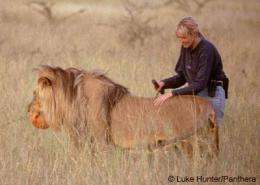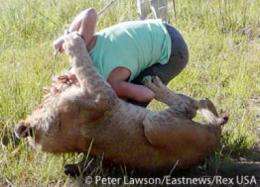Report: Captive lion reintroduction programs in Africa operate under 'conservation myth'

A new report published in the international conservation journal Oryx concludes that commercial 'wildlife encounter' operations across Africa promoting the reintroduction of captive lions do little to further the conservation of African lions in the wild.
Released 'Early Online' on July 31, 'Walking with lions: Why there is no role for captive-origin lions (Panthera leo) in species restoration,' was authored by a blue-ribbon panel of lion conservationists and wild cat biologists from Panthera, the IUCN Cat Specialist Group and a team of university-based lion researchers. Demonstrating that no lions have been successfully released as a result of this process, the report determines that commercial captive lion reintroduction programs operate largely under a 'conservation myth.'
The last two decades has seen a rapid growth of such operations especially across Southern Africa. Advertised as 'wildlife encounters,' the programs typically charge tourists and paying volunteers to pet, feed and walk with hand-raised and so-called tame lions. To the paying public, the stated objective is the eventual release to the wild of lions.

The Oryx paper assesses the potential of these programs to assist wild lion conservation by evaluating the role and suitability of captive lions for release. The report concludes that captive-bred lions are simply unnecessary for reintroduction projects. For more than two decades, wild lions have been translocated and rigorously monitored in over 40 parks across southern Africa with high success rates. Over 500 wild lions have been re-established by this process. More importantly, the evaluation shows that captive-bred lions and their offspring are poorly suited for survival and release compared to their wild-born counterparts.
The report's senior author and Panthera's President, Dr. Luke Hunter, explained, "The simple fact is, 'lion encounter' type programs do little to help conserve wild lions. We show that any sincere effort to re-establish lions simply has no reason to resort to captive animals; wild lions are already much better equipped to be wild. Releasing captive animals unnecessarily increases the costs, risks of failure and the danger - to both lions and humans."
The report also claims that captive-lion enterprises divert critical resources and attention from projects making a real impact on declining wild lion populations. Dr Paula White, an author of the paper and Director of the Zambia Lion Project at the University of California notes, "These operations charge the public to spend time with tame lions claiming that it contributes meaningfully to lion conservation. Imagine if that funding, and the sincere interest of the people paying it, was devoted to addressing the real reasons that wild lions are declining and threatened. Spending money to breed lions behind fences is not helping."
While perhaps more than 200,000 wild lions lived in Africa over a century ago, their numbers are now thought to be fewer than 30,000. Listed as 'Vulnerable' by the International Union for the Conservation of Nature and extirpated from over 80% of its natural range, the lion is now on track to share the fate of its distant cousin, the Endangered tiger.
Dr. Matthew Becker, CEO of the Zambian Carnivore Programme (and not an author on the report) notes "Certainly interacting with tame lions is a unique experience, but it's not conservation. We have such 'Walking with Lions' programs in Zambia and they require a continual stream of young imported lions, which live out their days in captivity because they are not suitable for release. Zambia doesn't need captive-bred lions versus increased protection of its wild populations and ecosystems. Help lions by supporting the classic walking safaris that occur in our magnificent protected areas - that's the real walking with lions."
Provided by Panthera
















